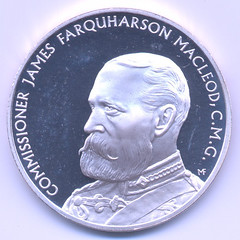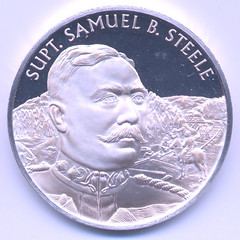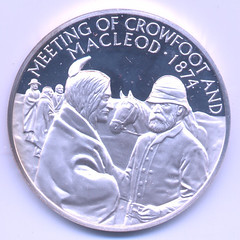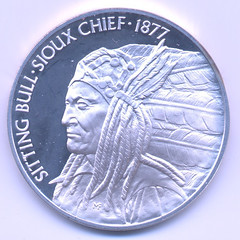
PREV ARTICLE
NEXT ARTICLE
FULL ISSUE
ROYAL CANADIAN MOUNTED POLICE MEDALSGeorge Manz is President of the Regina Coin Club and Fellow of the Royal Canadian Numismatic Association. He passed along this article to mark the 150th Anniversary of the Royal Canadian Mounted Police. Thank you. -Editor In 1973, to commemorate the 100th Anniversary of the founding of the Royal Canadian Mounted Police, the Wellings Mint produced 48 Sterling silver as well as 48 bronze medals. 2023 marks the 150th Anniversary of the RCMP so I'd like to share four of the medals that helped define the early days of the North West Mounted Police (NWMP) in the 1870s and 1880s. The NWMP was founded in 1873 by an Act of the Canadian Parliament shortly after American hunters and wolfers from Montana murdered sleeping First Nations Assiniboines. The purpose of the mounted armed force was to bring law and order to western Canada. In the summer of 1874, a force of several hundred Mounties rode west from the new province of Manitoba. They rode just north of the Canada-U.S. border on what is now called the Red Coat Trail, named after the colour of the coats that the Mounties wore. They were accompanied by a large contingent of Red River carts that carried their provisions, plus horses, oxen, cattle, mowing machines and field guns. After several months of travelling, they reached what is now called Fort Macleod and we begin the story of four medals that were struck in honour of their accomplishments. The first medal depicts James Macleod of the NWMP. Born in Scotland, Macleod moved to Ontario as a child along with his family. During his education at Queen's University, he joined the Volunteer Militia Field Battery of Kingston as a lieutenant. By 1870, he was commissioned as a brigade major and helped end the Red River Rebellion of Metis leader Louis Riel in 1870. Macleod later served as the second Commissioner of the NWMP from 1876 to 1880. Macleod died in 1894. The city of Fort Macleod, Alberta is named after him. The second medal shows the likeness of Samuel Steele. Steele attended Royal Military College of Canada, participated in the Red River Expedition and was the third officer sworn into the NWMP. During Steele's illustrious career, he met with American Chief Sitting Bull, participated in the North West Rebellion (often called the Riel Rebellion), and attained the rank of Superintendent. He later established customs posts to control the thousands of prospectors who flooded into the Yukon Territory following the discovery of gold in what is often called the Klondike Gold Rush. In 1900, when the Boer War started in South Africa, Canadian Pacific Railway tycoon Donald A. Smith, at his own expense, raised a cavalry unit called Strathcona's Horse. Smith asked Steele if he would become its commanding officer. Steele agreed. After the war ended, Steele became one of the leaders of the South African Constabulary. In 1914, after the outbreak of World War I, Steele became a commander of the 2nd Canadian Division. Steele died in 1918. Mount Steele, Canada's fifth tallest mountain, is named after him. Crowfoot was born in 1830. After his father died, his mother married another First Nations man and joined the Siksika First Nation, one of several tribes in the Blackfoot Confederacy. He fought in 19 battles with other First Nations and was wounded many times. His bravery helped him rise as one of the leaders of the Blackfoot. His leadership was vital when interlopers such as Hudson's Bay Company fur traders and later the NWMP arrived in his territory. He did not get involved in Louis Riel's North West Rebellion and later signed Treaty 7 along with other Blackfoot Chiefs. His people were promised land, farming tools, cattle, food and $5 every year. The promises were not always kept. Crowfoot died in 1890. At Blackfoot Historical Crossing Park, some of Crowfoot's possessions were repatriated from the Royal Albert Museum in Exeter and are now on display in Calgary. The final medal depicts the likeness of Sitting Bull, Lakota Sioux Chief. He was born about 1831. Part of his claim to fame was the famous 1876 Battle of the Little Big Horn, where his warriors wiped out the 7th Cavalry led by U.S. Lieutenant Colonel George Armstrong Custer. The U.S. government and army were determined to either wipe out the Sioux or place them on reservations. Deciding not to surrender, Sitting Bull led several thousand warriors, their wives and children across the border to Wood Mountain, North West Territories, now called Saskatchewan. He stayed there until 1881 when he and most of his band surrendered to U.S. troops. He died in 1890 when authorities tried to arrest him on Standing Rock Indian Reservation. Sitting Bull College is named after him. These and many more RCMP Centennial silver and bronze medals will be on display at the Regina Coin Club Spring Show, April 22-23, 2023. The show takes place at the Italian Club in Regina.
For more information on the Regina Coin Club, see:
Wayne Homren, Editor The Numismatic Bibliomania Society is a non-profit organization promoting numismatic literature. See our web site at coinbooks.org. To submit items for publication in The E-Sylum, write to the Editor at this address: whomren@gmail.com To subscribe go to: https://my.binhost.com/lists/listinfo/esylum All Rights Reserved. NBS Home Page Contact the NBS webmaster 
|




